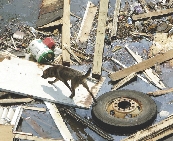MEDIA & TECHNOLOGY
Nonfiction gives facts through words and text features, including charts, diagrams, and maps. It can be print or other media like video. The explanations in nonfiction help readers and viewers learn about interesting things that have happened or are happening.
Writers of nonfiction tell what they think is important. What they choose to tell or omit affects the opinions of readers and viewers.
1 Conduct Research Look through newspapers and magazines and on the Internet. Find an interesting article about Hurricane Katrina. Read it carefully.
 Find an article about Hurricane Katrina.
Find an article about Hurricane Katrina.
Internet InsideNG.com2 Analyze Text Features Identify the text features, including photos, captions, maps, diagrams, and charts. Analyze the words and images that the writer uses. Think about
• what the writer chooses to tell about
• how the writing affects you
• whether the nonfiction piece is accurate
• what kind of information the features add.

News articles often include photos that touch readers’ emotions. How does this photo of hurricane damage affect you?
3 Recall the Video Think about the video you saw on Hurricane Katrina before you read this selection. Think about the images it shows and the main ideas it tells. Why do you think the writer chose those images? What opinion do you think the writer wants you to have about the event?
4 Compare Accounts Work with a small group. Compare the ideas in the print piece and in the video. Decide how each one causes you to think about the event. Which nonfiction piece gives a more effective explanation of what happened? Why?